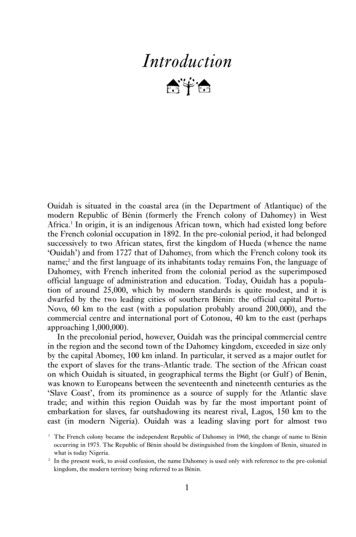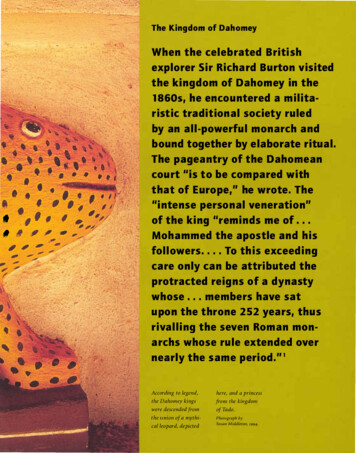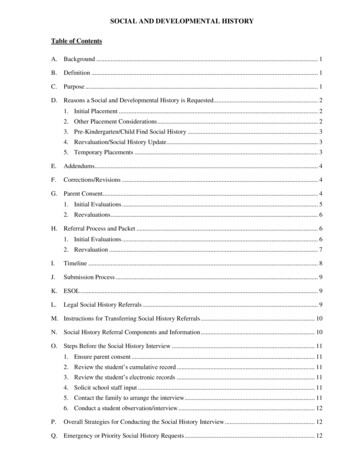
Transcription
IntroductionOuidah is situated in the coastal area (in the Department of Atlantique) of themodern Republic of Bénin (formerly the French colony of Dahomey) in WestAfrica.1 In origin, it is an indigenous African town, which had existed long beforethe French colonial occupation in 1892. In the pre-colonial period, it had belongedsuccessively to two African states, first the kingdom of Hueda (whence the name‘Ouidah’) and from 1727 that of Dahomey, from which the French colony took itsname;2 and the first language of its inhabitants today remains Fon, the language ofDahomey, with French inherited from the colonial period as the superimposedofficial language of administration and education. Today, Ouidah has a population of around 25,000, which by modern standards is quite modest, and it isdwarfed by the two leading cities of southern Bénin: the official capital PortoNovo, 60 km to the east (with a population probably around 200,000), and thecommercial centre and international port of Cotonou, 40 km to the east (perhapsapproaching 1,000,000).In the precolonial period, however, Ouidah was the principal commercial centrein the region and the second town of the Dahomey kingdom, exceeded in size onlyby the capital Abomey, 100 km inland. In particular, it served as a major outlet forthe export of slaves for the trans-Atlantic trade. The section of the African coaston which Ouidah is situated, in geographical terms the Bight (or Gulf ) of Benin,was known to Europeans between the seventeenth and nineteenth centuries as the‘Slave Coast’, from its prominence as a source of supply for the Atlantic slavetrade; and within this region Ouidah was by far the most important point ofembarkation for slaves, far outshadowing its nearest rival, Lagos, 150 km to theeast (in modern Nigeria). Ouidah was a leading slaving port for almost two12The French colony became the independent Republic of Dahomey in 1960, the change of name to Béninoccurring in 1975. The Republic of Bénin should be distinguished from the kingdom of Benin, situated inwhat is today Nigeria.In the present work, to avoid confusion, the name Dahomey is used only with reference to the pre-colonialkingdom, the modern territory being referred to as Bénin.1
Introductioncenturies, from the 1670s to the 1860s. During this period, the Bight of Benin isthought to have accounted for around 22 per cent of all slaves exported to theAmericas, and Ouidah for around 51 per cent of exports from the Bight.3 Given thecurrent consensual estimate of between 10 and 11 million slaves exported fromAfrica in this period, this suggests that Ouidah supplied well over a million slaves,making it the second most important point of embarkation of slaves in the whole ofAfrica (behind only Luanda, in Angola).4This prominence of Ouidah in the Atlantic slave trade is reflected in theoccurrence of versions of its name in various contexts in the African diaspora in theAmericas. For example, there is a village called ‘Widah’ in Jamaica, originally asugar plantation, presumably so named through being settled with slaves importedfrom Ouidah. In Haiti, one of the principal deities of the Afro-American vaudoureligion, the goddess Ezili, is distinguished in one of her forms as Ezili-FredaDahomi, ‘Ezili [of] Ouidah [in] Dahomey’;5 although one modern account hasargued that Ezili is a purely Haitian creation, without African antecedents, there isin fact in Ouidah to the present day a shrine of Azili (sic), a female river spirit, whois evidently the prototype of the Haitian goddess.6 The name of the town was alsocommemorated in that of the ship of the pirate Sam Bellamy, the Whydah, wreckedoff Cape Cod in what is now the USA in 1717, but located and excavated by marinearchaeologists, to become the subject of a museum exhibition in the 1990s, this shiphaving been originally, prior to its capture and appropriation by pirates, engaged inthe slave trade and named after the West African town.7 Ouidah’s prominence inEuropean commerce is also reflected in the application of the name Whidah-bird toa genus of the weaver-bird that is in fact common throughout tropical Africa butbecame familiar to the wider world through Ouidah; in English usage, the namewas commonly corrupted into ‘widow-bird’ (whence, rather than directly from thename Ouidah, its zoological name, Vidua), under which form it was celebrated in apoem by Shelley.In more recent times, Ouidah has figured in a historical novel dealing with theslave trade, by Bruce Chatwin, based on the career of the Brazilian slave-traderFrancisco Felix de Souza, who settled permanently in the town in the 1820s.8 Inthe 1990s a systematic attempt was made to exploit Ouidah’s historical role in theAtlantic slave trade for its promotion as a centre of ‘cultural tourism’, with thedevelopment of monuments to the slave trade and its victims along the road fromthe town to the beach where slaves were embarked, now designated ‘the slaves’345678David Eltis & David Richardson, ‘West Africa and the transatlantic slave trade: new evidence of long-runtrends’, S&A, 18 (1997), 16–35; David Eltis et al., ‘Slave-trading ports: towards an Atlantic-wideperspective’, in Robin Law & Silke Strickrodt (eds), Ports of the Slave Trade (Stirling, 1999), 12–34.These figures relate to the period 1650–1870. Perhaps a further 1 million slaves were exported before 1650;the Bight of Benin would have contributed a much smaller proportion of this earlier trade, and Ouidahvery little.Alfred Métraux, Le Vaudou haïtien (Paris, 1958), 22.Joan Dayan, Haiti, History and the Gods (Berkeley, 1998), 58; for Azili in Ouidah, see Chapter 3.Barry Clifford, Expedition Whydah (New York, 1999).Bruce Chatwin, The Viceroy of Ouidah (London, 1980). For de Souza, see below, Chapters 5–6.2
Introduction9route [la route des esclaves]’. This also led to the town featuring in televisionprogrammes dealing with the slave trade, including a BBC ‘Timewatch’ programme in 1997 and an episode of the African travels of Henry Louis Gates, Jr, in1999.10 What has hitherto remained lacking, however, is any study based on detailedresearch of the town’s history in general, or of its role in the Atlantic slave trade inparticular: a deficiency which this volume seeks to redress.Situating Ouidah’s historyThe present work represents, at one level, a continuation of my earlier research onthe history of the Slave Coast, and in particular its role as a source of supply for theAtlantic slave trade.11 A central concern of the present book, as of this earlier work,remains the organization of the African end of the slave trade, and the impact ofparticipation in this trade on the historical development of the African societiesinvolved. The present work, however, is informed by a significantly differentperspective. My earlier analysis was very much written from the viewpoint of theDahomian monarchy, in effect of the inland capital city of Abomey; and this focusis shared by other earlier work on the history of Dahomey, including the majorpublished studies by Ade Akinjogbin (1967) and Edna Bay (1998), and theunpublished doctoral theses of David Ross (1967) and John Reid (1986).12 Thismore recent research, on the other hand, in focusing on the coastal commercialcentre of Ouidah, represents, if not quite a view from below, nevertheless aperspective from what was, in political terms, the periphery rather than the centre.It therefore foregrounds rather different aspects of the operation of the slave trade,including especially the evolution of the merchant community in Ouidah, and inparticular the growth of a group of private traders that was distinct from theofficial political establishment, and whose relations with the Dahomian monarchygrew increasingly problematic over time.13910111213For slave trade commemoration in Ouidah, see Thereza A. Singleton, ‘The slave trade remembered on theformer Gold and Slave Coasts’, S&A, 20 (1999), 150-69; Roberta Cafuri, ‘Silenzi della memoria: la trattadegli schiavi’, Africa (Rome), 55/2 (2000), 244-60; Robin Law, ‘Memory, oblivion and return incommemoration of the Atlantic slave trade in Ouidah’, Republic of Bénin, in Ralph Austen (ed.), TheAtlantic Slave Trade in African and Diaspora Memory (forthcoming, Durham, N.C.). See also the officialBénin government publication, Nouréini Tidjani-Serpos & Patrick Écoutin, Ouidah, La Route des esclaves(English version, Ouidah, The Slave Route) (Cotonou, n.d.); and two local tourist guide-books: Martine deSouza & Mère Jah Evejah, Bienvenue à Ouidah au Bénin/Welcome to Ouidah in Benin (Ouidah, [1998]);Martine de Souza, Regard sur Ouidah/A Bit of History (Ouidah, 2000).‘The African Trade’, BBC 2, 1998; ‘The Slave Kingdoms’, episode in the series ‘Into Africa with HenryLouis Gates, Jr’, BBC 2, 1999.Esp. Robin Law, The Slave Coast of West Africa, 1550–1750 (Oxford, 1991).I.A. Akinjogbin, Dahomey and its Neighbours 1708–1818 (Cambridge, 1967); Edna G. Bay, Wives of theLeopard: Gender, Politics and Culture in the Kingdom of Dahomey (Charlottesville, 1998); David A. Ross,‘The autonomous kingdom of Dahomey 1818–1894’ (PhD thesis, University of London, 1967); John Reid,‘Warrior aristocrats in crisis: the political effects of the transition from the slave trade to palm oil commercein the nineteenth-century kingdom of Dahomey’ (PhD thesis, University of Stirling, 1986).For a preliminary treatment, see Robin Law, ‘The origins and evolution of the merchant community inOuidah’, in Law & Strickrodt, Ports of the Slave Trade, 55–70.3
IntroductionAfrican coastal entrepôts such as Ouidah played a critical role in the operation ofthe Atlantic slave trade, by helping to coordinate exchanges between hinterlandsuppliers and European ships, thereby accelerating their turn-round, and also bysupplying them with provisions to feed the slaves on their voyage.14 In addition toextending and deepening understanding of the working of the slave trade, a studyof Ouidah also represents a contribution to a second area of growing interestrecently within African historical studies, urban history. Studies of urban history inAfrica have tended to concentrate on the growth of towns during the colonial andpost-colonial periods;15 but in West Africa especially, substantial towns existedalready in the pre-colonial period, and Ouidah offers an exceptionally welldocumented case-study of this earlier tradition of urbanism.16 Within southernBénin, Ouidah provides the premier example of the ‘second generation’ of precolonial towns, which served as centres for European maritime trade: what havebeen termed, although somewhat infelicitously, ‘fort towns [villes-forts]’, indistinction from the ‘first generation’ of ‘palace-cities [cités-palais]’, which servedas capitals of indigenous African states, such as Abomey.17The study of African coastal communities such as Ouidah also has a relevancefor the currently fashionable project of ‘Atlantic history’, i.e. the attempt to treatthe Atlantic as a historical unit, stressing interactions among the various states andcommunities that participated in the construction and operation of the transAtlantic trading system.18 Although proponents of Atlantic history have tended toconcentrate on links between Europe and the Americas, it needs to be recognizedthat African societies were also active participants in the making of the Atlanticworld.19 If there was an ‘Atlantic community’, the African coastal towns whichserved as embarkation points for the trans-Atlantic slave trade were part of it, theircommercial and ruling elites being involved in political, social and culturalnetworks, as well as purely business linkages, which spanned the ocean.20 The studyof such African towns, moreover, adds an important comparative dimension to our14151617181920A.G. Hopkins, An Economic History of West Africa (London, 1973), 106–7.J.D.Y. Peel, ‘Urbanization and urban history in West Africa’, JAH, 21 (1980), 269–77.See David M. Anderson & Richard Rathbone (eds), Africa’s Urban Past (Oxford, 2000). This includes apreliminary treatment of the case of Ouidah: Robin Law, ‘Ouidah: a pre-colonial urban centre in coastalWest Africa, 1727–1892’, 85–97.For this classification, see Alfred Comlan Mondjannagni, Campagnes et villes au sud de la RépubliquePopulaire du Bénin (Paris, 1977), 295–341; the ‘third generation’ being towns that served as administrativeor commercial centres within the colonial system, and the ‘fourth generation’ the unique case of Cotonouas the modern economic and de facto political capital of Bénin. These ‘generations’, it should be stressed,are not to be understood necessarily as distinguishing among different groups of towns, since they mayrepresent successive periods in the history of a single town: for example, Ouidah itself originated as a townof the ‘second generation’ but then developed as a colonial town of the ‘third generation’. The term ‘villesforts’ seems unfortunate since, as Mondjannagni acknowledges (309–10), the European commercialestablishments in them were not necessarily (and for example in Ouidah were not originally) fortified.E.g. Bernard Bailyn, ‘The idea of Atlantic history’, Itinerario, 20/1 (1996), 38–44.See John Thornton, Africa and Africans in the Making of the Atlantic World, 1400–1680 (Cambridge, 1992).Robin Law & Kristin Mann, ‘West Africa in the Atlantic community: the case of the Slave Coast’, WMQ,56/2 (1999), 307–34; also Robin Law, ‘The port of Ouidah in the Atlantic community’, in HorstPietschmann (ed.), Atlantic History: History of the Atlantic System 1580–1830 (Göttingen, 2002), 349–64.4
Introductionunderstanding of the growth and functioning of port cities in the Atlantic world inthe era of the slave trade, since previous studies of Atlantic port towns in thisperiod have concentrated on ports in the Americas.21 But such American portswere European colonial creations, which functioned as enclaves or centres ofEuropean power, a model that is not applicable to Atlantic ports in Africa, whichremained under indigenous sovereignty (apart from the exceptional case of Luandain Angola, which uniquely had already become a Portuguese colony in thesixteenth century).There have been a number of studies of particular West African coastal ‘port’communities in the pre-colonial period, which have served to delineate a number ofgeneral issues in their history: the organization of overseas commerce, therelationships between ports and their hinterlands, the effects of their involvementin Atlantic commerce on their political and social structures and demographicgrowth, and the problems posed for them by the transition from the slave trade toexports of agricultural produce such as palm oil in the nineteenth century.22 Muchof this work, however, has dealt with the general history of the states orcommunities in which ports were situated, rather than with the specific history ofthe port towns themselves. Examples are, within the Slave Coast, studies of twocoastal communities west of Ouidah, the Gen kingdom (which included the port ofLittle Popo, modern Aného) by Nicoué Gayibor, and the Anlo confederacy(including the port of Keta) by Sandra Greene.23 Those studies which have focusedon the history of coastal towns specifically have generally related to communitieswhich were ‘city-states’, in the sense of being independent of outside politicalauthority: examples being, on the eastern Slave Coast, the study of Badagry byCaroline Sorensen-Gilmour; and beyond the Slave Coast, in the Bight of Biafra tothe east, those of Bonny by Susan Hargreaves, of New Calabar by WaibinteWariboko, Old Calabar by John Latham, and Douala by Ralph Austen andJonathan Derrick.24 In consequence, these have a rather different and more diffusefocus than the present work, which seeks to highlight especially the developmentand functioning of Ouidah as an urban community. The work which comes closestto my own concerns among earlier studies of West African port communities isHarvey Feinberg’s study of Elmina, on the Gold Coast (modern Ghana), to thewest.25 But Elmina was a very different sort of place from Ouidah, not only in being2122232425E.g. Franklin W. Knight & Peggy K. Liss (eds), Atlantic Port Cities (Princeton, 1991).See the studies collected in Law & Strickrodt, Ports of the Slave Trade.Nicoué L. Gayibor, Le Genyi (Lomé, 1990); Sandra E. Greene, Gender, Ethnicity and Social Change on theUpper Slave Coast: A History of the Anlo-Ewe (London, 1996). See also Silke Strickrodt, ‘Afro-Europeantrade relations on the western Slave Coast, 16th to 19th centuries’ (PhD thesis, University of Stirling, 2003).Caroline Sorensen-Gilmour, ‘Badagry 1784-1863’ (PhD thesis, University of Stirling, 1995); Susan M.Hargreaves, ‘The political economy of nineteenth-century Bonny’ (PhD thesis, University of Birmingham,1987); W.E. Wariboko, ‘New Calabar and the forces of change, c. 1850–1945’ (PhD thesis, University ofBirmingham, 1991); A.J.H. Latham, Old Calabar 1600–1891 (Oxford, 1973); Ralph A. Austen & JonathanDerrick, Middlemen of the Cameroons Rivers: The Duala and their Hinterland, c. 1600–c. 1960 (Cambridge,1999).Harvey Feinberg, Africans and Europeans in West Africa: Elminans and Dutchmen on the Gold Coast duringthe Eighteenth Century (Philadelphia, 1989).5
Introductiona ‘city-state’, but also in the preponderant influence exercised there by a Europeanpower, in the form of the Dutch West India Company, so that its history, inrelation to that of Ouidah, is illuminating as much by way of contrasts as ofsimilarities.The case of Ouidah may also serve to refine or qualify some of the conventionalconceptual categories that have been applied to West African ‘port’ communities.In the most general terms, Ouidah can be interpreted as a ‘middleman’ community:this term being understood, as Austen and Derrick propose for the case of Douala,not only in relation to the exchange of commodities, but also with reference to therole of such coastal communities as intermediaries in the transmission of culturalinfluences, and in the longer term in mediating the accommodation of Africansocieties to European economic and political dominance.26 However, the morespecific categories that have been developed in order to elucidate the interstitialposition of African coastal ‘middleman’ communities seem more problematic. Theconcept of an ‘enclave-entrepôt’, applied to Elmina by Feinberg, for example, doesnot fit the case of Ouidah, where European power was much more limited, andwhich in this was a more typical case.27 That of a neutral ‘port of trade’,propounded by economic anthropologists of the ‘substantivist’ school, such as KarlPolanyi, although elaborated with reference to the specific case of Ouidah, is not infact sustained by the detailed empirical evidence relating to the operation of theAtlantic trade there.28Chronologically, this study concentrates on the period of Dahomian rule overOuidah, after 1727, although an introductory chapter deals with the town’s origins,including its earlier history under the Hueda kingdom. The justification for thisemphasis relates basically to the nature of the available source material, which ismuch more abundant for the Dahomian period. This, however, also reflects the factthat Ouidah became much more important under Dahomian rule, not only as acommercial centre, but also now as a centre of provincial administration. The studyeffectively concludes with the French occupation in 1892, although with a briefepilogue treating the fate of the town under colonial rule. This has been done withsome hesitation, since in general there is a strong case for downplaying theconventional perception of the establishment of colonial rule as a watershed, andfor tracing continuities and transformations in the ‘middleman’ role into thecolonial period, as was illuminatingly done by Austen and Derrick for the case ofDouala.29 However, whereas in the cases of ports that remained prominent into thecolonial period – such as Accra in Ghana, and Lagos in Nigeria, as well as Doualain Cameroun – the reality of continuity is transparent, this is less true of Ouidah,26272829Austen & Derrick, Middlemen, 1–4.Feinberg, Africans and Europeans, 1–6, 155–8.Rosemary Arnold, ‘A port of trade: Whydah on the Guinea Coast’, in Karl Polanyi et al. (eds), Trade andMarket in the Early Empires (New York, 1957), 154–76; Karl Polanyi, Dahomey and the Slave Trade (Seattle,1966), 96–139.See also the emphasis on pre-colonial antecedents by John Parker, Making the Town: Ga State and Societyin Early Colonial Accra (Oxford, 2000), xviii–xix; although the study itself focuses on the period of colonialrule.6
Introductionwhere the imposition of colonial rule represented more of a historical break. Theexperience of Ouidah under colonialism was essentially of economic and politicalmarginalization; although this process had begun already in the second half of thenineteenth century, and was only intensified and accelerated by the changedconditions of colonial rule.Reconstructing Ouidah’s historyApart from its intrinsic interest as one of the leading African slave-trading ports,the case of Ouidah also warrants study because the documentation available for itshistory is exceptionally rich, and serves to pose or illustrate some significantmethodological issues of more general relevance in the field of pre-colonial Africanhistory, especially in the possibilities of combination of information from differentcategories of material: basically, as between foreign (European) contemporary andlocal traditional sources.30The greatest mass of detailed documentation for the history of Ouidah derivesfrom the European commercial presence, although the most useful sources are notin fact those deriving directly and specifically from the conduct of European trade.The most informative sources for the eighteenth century are the records of thepermanently organized fortified factories which the three leading Europeannations involved – the French, English and Portuguese – maintained in Ouidah;31among which, the best preserved are those of the English.32 These provide detaileddocumentation of the forts’ day-to-day activities and interactions with the rest ofthe community, and thus constitute a rich source for the social and political, as wellas the narrowly economic history of the town. With the legal abolition of the slavetrade in the early nineteenth century, these forts were abandoned, leavingsomething of a hiatus in the evidence until the 1840s. In the middle decades of thenineteenth century, documentation on the town’s history is provided above all bythe records of the British government, relating to its campaign to suppress the nowillegal slave trade, which included the maintenance of a vice-consulate in Ouidahbetween 1849 and 1852. The French government also intervened in Dahomey, todefend France’s commercial interests, from the 1850s, and likewise maintained avice-consulate in Ouidah from 1863. Some material is also provided by Christianmissions that operated in the town: British Methodists in 1854–67, and FrenchCatholics in 1861–71 and again from 1884. There are also a number of detailed303132On this, this study represents a more optimistic perspective than that of Ralph A. Austen, ‘The slave tradeas history and memory: confrontations of slaving voyage documents and communal traditions’, WMQ, 58(2001), 229–44.Only the French fort has been the subject of detailed study: Simone Berbain, Le Comptoir français de Juda(Ouidah) au XVIIIe siècle (Paris, 1942).Since the original foundation of this factory, in the 1680s, predated the Union of England and Scotland(1707), it is properly called ‘English’ in its earliest phase. Strictly, it later became ‘British’, but insistence onthis distinction can tend towards pedantry, especially as the word for ‘British’ in Fon (as also in French) isin fact ‘English [Glensi]’; I have therefore continued to refer to the ‘English fort’ in conformity with localusage.7
Introductionpublished accounts by European visitors to Ouidah in this period, among whichthe most informative are those of the Scottish explorer John Duncan in 1845, theBritish naval officer (engaged in the anti-slaving squadron) Frederick Forbes in1849–50, and the British consul (and pioneer anthropologist) Richard Burton in1863–4.33Source material of local provenance also includes some contemporary writtenmaterial, deriving from the community of settlers from Brazil that was establishedin the town in the nineteenth century. Occasional items of correspondence from oraddressed to Brazilian traders resident in Ouidah are preserved in overseasarchives, especially in Britain among papers seized from illegal slave shipsintercepted by the British navy. Little comparable material seems to have beenpreserved in Ouidah itself, although it is frequently claimed that written recordswhich once existed were destroyed by fire or other hazards. A few items do,however, survive in local possession (or at least did so until recently), notably aletter-book of the Brazilian trader José Francisco dos Santos, containing correspondence from 1844–7 and 1862–71;34 and the will of Antonio d’Almeida, anAfrican-born freed slave who had returned from Brazil to resettle in Africa, madeout at Ouidah in 1864.35More substantial, as well as of greater chronological depth, is the informationprovided by local traditions. Much of this material also exists already in writtenform. Two surveys of Ouidah traditions were made by French colonial officials,Marcel Gavoy in 1913 and Reynier in 1917; the purpose of the collection of thismaterial was explicitly to understand the existing political system, in order toinform administrative arrangements under French colonial rule.36 Although thesewere published only many years later, they evidently circulated in Ouidah intypescript earlier, and have exercised considerable influence on local perceptions ofhistory.There is also a substantial tradition of local historical writing by African authors.Among such works by local writers, the earliest was a study of Ouidah ‘origins’published in a Roman Catholic church journal in 1925–6, by Paul Hazoumé, aleading figure in the literary history of Bénin, who was in origin from Porto-Novorather than Ouidah, but had worked for several years as a schoolmaster in the lattertown.37 The most substantial local history (and an indispensable source and guide3334353637John Duncan, Travels in Western Africa (London, 1847); Frederick E. Forbes, Dahomey and the Dahomans(London, 1851); Richard F. Burton, A Mission to Gelele, King of Dahome (London, 1864).Published in French translation by Pierre Verger, ‘Cent-douze lettres de Alfaiate’, in Verger et al., Les Afroaméricains (Dakar, 1952), 53–99 (cited hereafter as ‘Dos Santos correspondence’). Recent enquiries inOuidah failed to confirm the continued existence of this letter-book in the dos Santos household there; itmay be in the possession of a family member resident outside the town.Ibid., 21–3; with original Portuguese text in Pierre Verger, Os libertos: sete caminhos na liberdade de escravosda Bahia no século XIX (Salvador, Bahia, 1992), 121–4.‘Note historique sur Ouidah par l’Administrateur Gavoy (1913)’, ED, 13 (1955), 45–70; ANB, 1E146,‘Recherches sur l’organisation intérieure du commandement indigène’, by Reynier, Ouidah, 1 Dec. 1917,published as ‘Ouidah: organisation du commandement’, Mémoire du Bénin, 2 (1993), 30-68.Paul Hazoumé, ‘Aperçu historique sur les origines de Ouidah’, in 6 parts (apparently incomplete), in LaReconnaissance africaine, nos 4–5, 7–8, 10–11 (1925–6).8
Introductionfor the modern historian) is a book by Casimir Agbo, published in 1959.38 Thereare also a number of histories of particular Ouidah families. Traditions of the deSouza family, descended from the Francisco Felix de Souza mentioned above, werepublished by Norberto Francisco de Souza, a grandson of the founder andsuccessor to the headship of the family, in 1955; and a more extended compilationof material from various sources was published by Simone de Souza, aFrenchwoman married into the family, in 1992.39 Substantial histories also exist ofthe Dagba family, descended from a man who served as Yovogan, or Dahomiangovernor, of Ouidah for an exceptionally long period in the nineteenth century(1823–1870s); and of the Quénum family, who were the most prominentindigenous Dahomian merchants in the town in the second half of the nineteenthcentury.40 This material available already in written form has been supplemented bylocal fieldwork undertaken by myself, during several visits to Ouidah between1992–2001. Besides interviewing informants in the town, this has involvedextensive conversations with experts in local history, including members of thestaff of the Historical Museum of Ouidah: especially Martine de Souza, one of themuseum guides (and a great-great-great-granddaughter of the original de Souza).Something may be said here of the character of historical ‘tradition’ in Ouidah.First, it should be stressed that it is not exclusively ‘oral’; not only has much of itbeen recorded in writing, as has been seen, since the early twentieth century, but ithas also evolved in interaction with written sources. Gavoy’s survey of 1913 alreadyrepresents an attempt to combine local traditions with information derived fromcontemporary European sources; and this conflation of written and oral materialhas remained characteristic of local history writing in Ouidah ever since. Agbo’sHistoire, for example, cites the earlier studies of Gavoy and Reynier, together withpublished sources, as well as additional material of his own; the latter includingreminiscences of persons with direct personal experience of the late pre-colonialperiod, as well as more strictly ‘traditional’ material relating to earlier times. InOuidah, as in coastal West Africa more generally, the ‘traditions’ current nowadaysin oral form are regularly subject to the influence of ‘feedback’ fr
Atlantic trading system.18 Although proponents of Atlantic history have tended to concentrate on links between Europe and the Americas, it needs to be recognized that African societies were also active participants in the making of the Atlantic world.19 If there was an 'Atlantic community', the African coastal towns which










